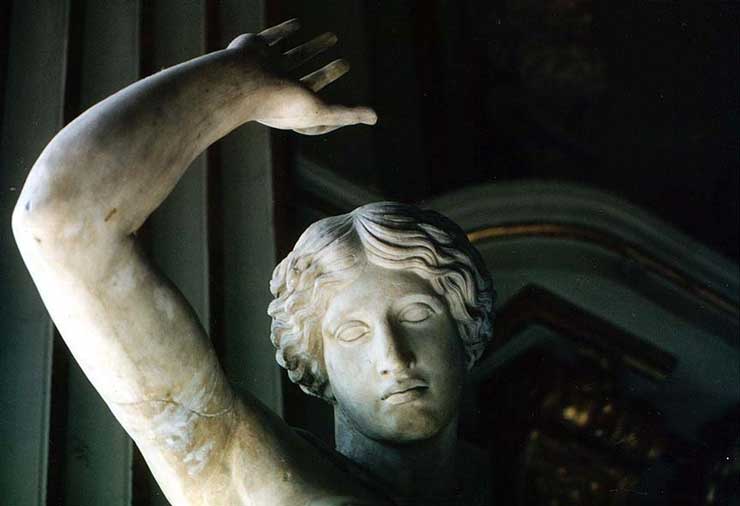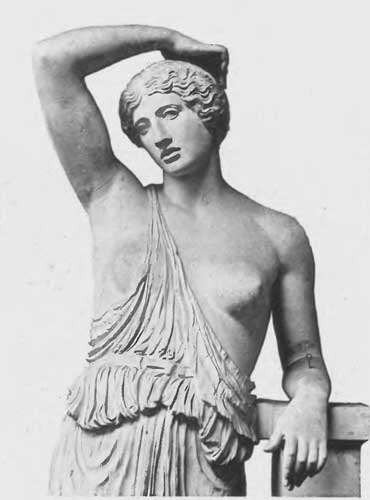.

Wounded Amazon, Capitoline Museum, The Sosicles type
Pliny the Elder records (Nat Hist. 34.75) five bronze statues of Amazons in the Artemision of Ephesus. He explains the existence of such a quantity of sculptures on the same theme in the same place by describing a 5th century BC competition between the artists Polyclitus, Phidias, Kresilas, Kydon and Phradmon thus :
“ The most celebrated of these artists, though born at different epochs, have joined in a trial of skill in the Amazons which they have respectively made. When these statues were dedicated in the Temple of Diana at Ephesus, it was agreed, in order to ascertain which was the best, that it should be left to the judgment of the artists themselves who were then present: upon which, it was evident that that was the best, which all the artists agreed in considering as the next best to his own. Accordingly, the first rank was assigned to Polycletus, the second to Phidias, the third to Cresilas, the fourth to Cydon, and the fifth to Phradmon. ”
This anecdote is backed by the existence of three types of Roman marble copy of the wounded Amazon, whose lost originals may be dated to 430 BC on stylistic grounds. These three types are identified with three of Pliny's five sculptures (the type derived from Phradmon is lost, and the designation of the Kydon type is probably explained by a textual mistaking of Kresilas's place of birth - Kydonia - for the name of a fifth sculptor). However, only the identification of the Mattei type as deriving from Phidias's original is undisputed. The assignment of the Sciarra-type as deriving from Polyclitus's original and Sosicles-type as deriving from Kresilas's original (or vice versa), on the other hand, is undiminished although having been discussed since 1897. The German scholar R. Bolnach has written a thorough form-analysis for the Sciarra/Polyklet and Sosikles/Kresilas pairings.
Types
All three types show a standing female with a similar head and face, and (as with the Venus Genetrix) are clothed in a peplos that has fallen from one or both shoulders to leave her bare-breasted. Their differences are most obvious when the three sculptures, or casts therof, are displayed together, as at the Casts Gallery at the Cambridge Classics Faculty.
Amazon Mattei type
2.11m high, and of the Augustan era, this type is derived from Phidias's original. Discovered in 1770 and taken into the Mattei collection, it is now in the Vatican Museums. The figure looks down, with her right arm parrying and her left arm by her side with a quiver under it, though both arms, the head, and the left shoulder are all restorations. (Another copy of this type is at the Capitoline Museums.[1])

Amazon Sciarra Type Berlin Antikensammlung
Amazon Sciarra type
1.94 m high, this copy dates to the era of Tiberius and is derived from Polyclitus's or Kresilas's original. It was found in Rome in 1868 in the Gardens of Sallust, and is now in the Ny Carlsberg Glyptotek, Copenhagen (K176). The figure is resting her left arm on a column and her right hand behind her head, with her face leaning to one side. Her nose, right arm from the deltoid muscle downwards, the left forearm below the elbow, both hands, and the right foot and ankle have all been restored since discovery.
Sosicles type
This type is known principally from the 2.02 m high 2nd century AD marble copy (signed by Sosicles), deriving from Polyclitus's or Kresilas's original. It was discovered in 1733, went into the collection of Cardinal Albani, and is now in the Capitoline Museums, Rome (Room 33). The figure has her left arm across her body below her breasts, and her right hand raised and open-palmed, as she looks down towards the wound in her right-hand side. She wears a baldric. The tip of nose, lower lip, left forearm, and hand with drapery have been restored since discovery.[2]
It was (before and after Sosicles's time) copied as a complete statue, as a bust or as a herm, both in stone in the same size as the original and in miniature in bronze.
Lansdowne Amazon
A possible fourth is the Lansdowne Amazon, said to have been found in Tor Colombare by Gavin Hamilton, though it may be a variant on the Sciarra-type. Later attested at Lansdowne House, it is now at the Metropolitan Museum of Art.[3] Half of the nose, the right arm from middle of the biceps to wrist, the tip of the thumb, and other details have been restored since discovery.
References
Sosicles type
Künstlerlexikon der Antike II (2004) 411 s.v. Sosikles (R. Vollkommer)
Hans von Steuben: Die Amazone des Polyklet, in: Polykletforschungen, ed. by Herbert Beck and Dieter Bol, Berlin 1993, pp. 73-102
Links
- The three Amazons
Smith
- AJA
- Brunilde Sismondo Ridgway, A Story of Five Amazons, Vol. 78, No. 1 (Jan., 1974), pp. 1-17
- 2000
- Ernest Gardner, A Head in the Possession of Philip Nelson, ESQ., M. B., The Journal of Hellenic Studies, Vol. 18, 1898 (1898), pp. 141-146
| Ancient Greece
Science, Technology , Medicine , Warfare, , Biographies , Life , Cities/Places/Maps , Arts , Literature , Philosophy ,Olympics, Mythology , History , Images Medieval Greece / Byzantine Empire Science, Technology, Arts, , Warfare , Literature, Biographies, Icons, History Modern Greece Cities, Islands, Regions, Fauna/Flora ,Biographies , History , Warfare, Science/Technology, Literature, Music , Arts , Film/Actors , Sport , Fashion --- |
Retrieved from "http://en.wikipedia.org/"
All text is available under the terms of the GNU Free Documentation License

